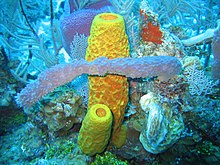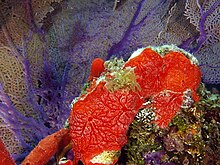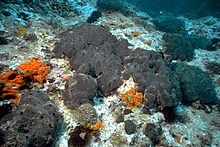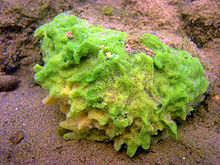Demosponge
| Demosponge Temporal range: Cryogenian – present,
| |
|---|---|

| |
| Included are the yellow tube sponge, Aplysina fistularis, the purple vase sponge, Niphates digitalis, the red encrusting sponge, Spiratrella coccinea, and the gray rope sponge, Callyspongia sp. | |
| Scientific classification | |
| Domain: | Eukaryota |
| Kingdom: | Animalia |
| Phylum: | Porifera |
| Class: | Demospongiae Sollas, 1885 |
| Subclasses | |






Demosponges (Demospongiae) are the most diverse
The many diverse
Because of many species' long life span (500–1,000 years) it is thought that analysis of the aragonite skeletons of these sponges could extend data regarding ocean temperature, salinity, and other variables farther into the past than has been previously possible. Their dense skeletons are deposited in an organized chronological manner, in concentric layers or bands. The layered skeletons look similar to reef corals. Therefore, demosponges are also called coralline sponges.
Classification and systematics
The Demospongiae have an ancient history. The first demosponges may have appeared during the
The Systema Porifera (2002) book (2 volumes)[1] was the result of a collaboration of 45 researchers from 17 countries led by editors J. N. A. Hooper and R. W. M. van Soest. This milestone publication provided an updated comprehensive overview of sponge systematics, the largest revision of this group (from genera, subfamilies, families, suborders, orders and class) since the start of spongiology in the mid-19th century. In this large revision, the extant Demospongiae were organized into 14 orders that encompassed 88 families and 500 genera. Hooper and van Soest (2002) gave the following classification of demosponges into orders:
- Subclass HomoscleromorphaBergquist 1978
- Homosclerophorida Dendy 1905
- Subclass Tetractinomorpha
- AstrophoridaSollas 1888
- ChondrosidaBoury-Esnault & Lopès 1985
- HadromeridaTopsent 1894
- LithistidaSollas 1888
- SpirophoridaBergquist & Hogg 1969
- Subclass CeractinomorphaLévi 1953
- Agelasida Verrill 1907
- Dendroceratida Minchin 1900
- Dictyoceratida Minchin 1900
- HalichondridaGray 1867
- HalisarcidaBergquist 1996
- Haplosclerida Topsent 1928
- Poecilosclerida Topsent 1928
- Verongiida Bergquist 1978
- VerticillitidaTermier & Termier 1977
However, molecular and morphological evidence show that the
Morrow & Cárdenas (2015)
- Subclass Heteroscleromorpha Cárdenas, Pérez, Boury-Esnault, 2012
- order Agelasida Verrill, 1907
- order Axinellida Lévi, 1953
- order Biemnida Morrow et al., 2013
- order Bubarida Morrow & Cárdenas, 2015
- order Clionaida Morrow & Cárdenas, 2015
- order DesmacellidaMorrow & Cárdenas, 2015
- order Haplosclerida Topsent, 1928
- order Merliida Vacelet, 1979
- order Poecilosclerida Topsent, 1928
- order PolymastiidaMorrow & Cárdenas, 2015
- order ScopalinidaMorrow & Cárdenas, 2015
- order SphaerocladinaSchrammen, 1924
- order Spongillida Manconi & Pronzato, 2002
- order Suberitida Chombard & Boury-Esnault, 1999
- order Tethyida Morrow & Cárdenas, 2015
- order Tetractinellida Marshall, 1876
- order TrachycladidaMorrow & Cárdenas, 2015
- Heteroscleromorpha incertae sedis
- Subclass Verongimorpha Erpenbeck et al., 2012
- order Chondrillida Redmond et al., 2013
- order Chondrosiida Boury-Esnault et Lopès, 1985
- order VerongiidaBergquist, 1978
- Subclass Keratosa Grant, 1861
- order Dendroceratida Minchin, 1900
- order Dictyoceratida Minchin, 1900
Sclerosponges
Sclerosponges were first proposed as a class of sponges, Sclerospongiae, in 1970 by Hartman and Goreau.
Chaetetids
Chaetetids, more formally called "chaetetid hyper-calcified demosponges" (West, 2011), are common calcareous
-
Fossil chaetetid from theUpper Carboniferous) of southern Nevada.
-
Cross-section of a fossil chaetetid (Bird Spring Formation, Upper Carboniferous, Nevada.
Reproduction

Spermatocytes develop from the transformation of
Methods of asexual reproduction include both budding and the formation of gemmules. In budding, aggregates of cells differentiate into small sponges that are released superficially or expelled through the oscula. Gemmules are found in the freshwater family Spongillidae. They are produced in the mesohyl as clumps of archeocytes, are surrounded with a hard layer secreted by other amoebocytes. Gemmules are released when the parent body breaks down, and are capable of surviving harsh conditions. In a favorable situation, an opening called the micropyle appears and releases amoebocytes, which differentiate into cells of all the other types.
Meiosis and recombination
The cytological progression of porifera oogenesis and spermatogenesis (gametogenesis) shows great similarity to other metazoa.[20] Most of the genes from the classic set of meiotic genes conserved in eukaryotes are upregulated in the sponges Geodia hentscheli and Geodia phlegraei including genes for DNA recombination.[20] Since porifera are the earliest divergent animals, these findings indicate that the basic toolkit of meiosis and recombination were present early in eukaryote evolution.[20]
Economic importance
The most economically important group of demospongians to human are the bath sponges. These are harvested by divers and can also be grown commercially. They are bleached and marketed; the spongin gives the sponge its softness.
Citations
- .
- PMID 22558119.
- ^ "World Porifera Database". marinespecies.org. Retrieved 21 October 2015.
- ^ ISBN 978-0-03-056747-6.
- .
- ^ Divergence times in demosponges (Porifera) - bioRxiv
- PMID 26507690.
- S2CID 4314662. Archived from the original(PDF) on 2018-07-24. Retrieved 2019-01-27.
- ^ Gordon D, Love et al., "Fossil steroids record the appearance of Demospongiae during the Cryogenian period", Nature, 2009
- .
- .
- ^ Finks, R.M. (1970). "The evolution and ecologic history of sponges during Palaeozoic times". Symposium of the Zoological Society of London. 25: 3–22.
- S2CID 14468684.
- PMID 25901176.
- ^ "World Porifera Database".
- ^ Hartman, W.D.; Goreau, T.F. (1970). "Jamaican coralline sponges: Their morphology, ecology and fossil relatives". Symp. Zool. Soc. Lond. 25: 205–243. (Cited by "Notes of the Sclerosponge Workshop". Stable Isotope Laboratory, Rosenstiel School of Marine and Atmospheric Science. Miami, FL: University of Miami. 21–23 March 1998. Archived from the original on 18 August 2018. Retrieved 19 December 2018.)
- ^ Vacelet, J. (1985). "Coralline sponges and the evolution of the Porifera". System. Assoc. Spec. 28: 1–13.
- ^ Reitner, J. (1992). "Coralline Spongien. der Versuch einer phylogenetisch-taxonomischen Analyse". Berliner Geowissenschaftliche Abhandlungen Reihe e (Paläobiologie). 1: 1–352.
- ^ a b c Koutsouveli V, Cárdenas P, Santodomingo N, Marina A, Morato E, Rapp HT, Riesgo A. The Molecular Machinery of Gametogenesis in Geodia Demosponges (Porifera): Evolutionary Origins of a Conserved Toolkit across Animals. Mol Biol Evol. 2020 Dec 16;37(12):3485-3506. doi: 10.1093/molbev/msaa183. PMID: 32929503; PMCID: PMC7743902
- ^ J. N. A. Hooper and R. W. M. van Soest (2002). "Class Demospongiae Sollas, 1885". Systema Porifera. A guide to the classification of sponges. New York, Boston, Dordrecht, London, Moscow: Kluwer Academic/Plenum Publishers.
- PMID 15288059.
General references
- Barnes, R. S. K. et al. (2001). The Invertebrates: A Synthesis. Oxford: Blackwell Science. ISBN 0-632-04761-5.
- Bergquist, P. R. Sponges. Berkeley, CA: University of California Press; 1978. pp. 86–103.
- Hickman, C. P. Biology of the Invertebrates. Saint Louis, MO: C. V. Mosely Publishing.
- Kozloff, E. N. Invertebrates. Philadelphia, PA: Saunders College Publishing; 1990. pp. 74–91.
- Kelly-Borges M.; Pomponi S. A. (1994). "Phylogeny and classification of lithistid sponges (Porifera: Demospongiae): a preliminary assessment using ribosomal DNA sequence comparisons". Molecular Marine Biology and Biotechnology. 3 (2): 87–103. PMID 8087187.
- Reitner, J. and D. Mehl. 1996. Monophyly of the Porifera. Verhandlungen des Naturwissenschaftlichen Vereins in Hamburg. 36: 5–32.
- West, R. R. 2011. Part E, Revised, Volume 4, Chapter 2A: "Introduction to the fossil hypercalcified chaetetid-type Porifera (Demospongiae)". Treatise Online 20: 1–79.



